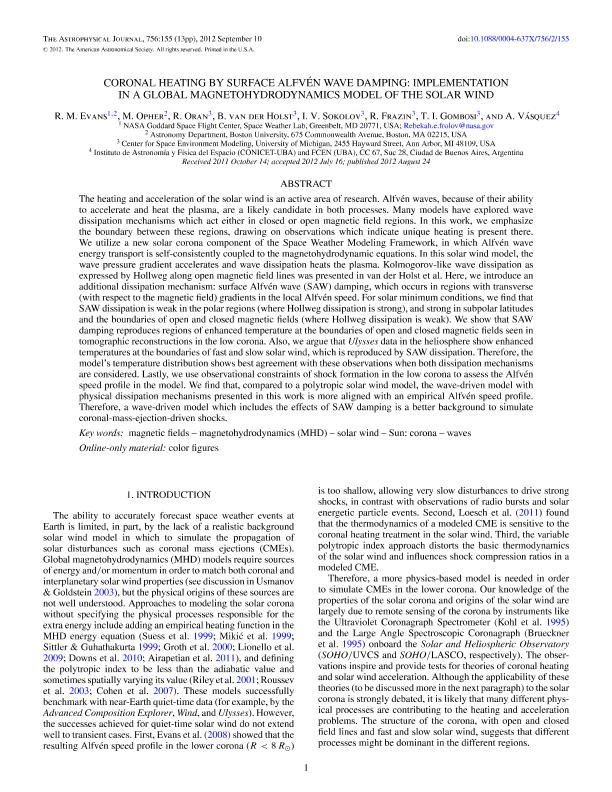Mostrar el registro sencillo del ítem
dc.contributor.author
Evans, Rebekah M.
dc.contributor.author
Opher, M.
dc.contributor.author
Oran, R.
dc.contributor.author
van der Holst, Bartholomeus
dc.contributor.author
Sokolov, I.V.
dc.contributor.author
Frazin, Richard A.
dc.contributor.author
Gombosi, Tamas I.
dc.contributor.author
Vasquez, Alberto Marcos

dc.date.available
2019-05-22T17:01:50Z
dc.date.issued
2012-09
dc.identifier.citation
Evans, Rebekah M.; Opher, M.; Oran, R.; van der Holst, Bartholomeus; Sokolov, I.V.; et al.; Coronal heating by surface Alfvén wave damping: Implementation in a global magnetohydrodynamics model of the solar wind; IOP Publishing; Astrophysical Journal; 756; 2; 9-2012; 155-168
dc.identifier.issn
0004-637X
dc.identifier.uri
http://hdl.handle.net/11336/76866
dc.description.abstract
The heating and acceleration of the solar wind is an active area of research. Alfvén waves, because of their ability to accelerate and heat the plasma, are a likely candidate in both processes. Many models have explored wave dissipation mechanisms which act either in closed or open magnetic field regions. In this work, we emphasize the boundary between these regions, drawing on observations which indicate unique heating is present there. We utilize a new solar corona component of the Space Weather Modeling Framework, in which Alfvén wave energy transport is self-consistently coupled to the magnetohydrodynamic equations. In this solar wind model, the wave pressure gradient accelerates and wave dissipation heats the plasma. Kolmogorov-like wave dissipation as expressed by Hollweg along open magnetic field lines was presented in van der Holst et al. Here, we introduce an additional dissipation mechanism: surface Alfvén wave (SAW) damping, which occurs in regions with transverse (with respect to the magnetic field) gradients in the local Alfvén speed. For solar minimum conditions, we find that SAW dissipation is weak in the polar regions (where Hollweg dissipation is strong), and strong in subpolar latitudes and the boundaries of open and closed magnetic fields (where Hollweg dissipation is weak). We show that SAW damping reproduces regions of enhanced temperature at the boundaries of open and closed magnetic fields seen in tomographic reconstructions in the low corona. Also, we argue that Ulysses data in the heliosphere show enhanced temperatures at the boundaries of fast and slow solar wind, which is reproduced by SAW dissipation. Therefore, the model's temperature distribution shows best agreement with these observations when both dissipation mechanisms are considered. Lastly, we use observational constraints of shock formation in the low corona to assess the Alfvén speed profile in the model. We find that, compared to a polytropic solar wind model, the wave-driven model with physical dissipation mechanisms presented in this work is more aligned with an empirical Alfvén speed profile. Therefore, a wave-driven model which includes the effects of SAW damping is a better background to simulate coronal-mass-ejection-driven shocks. © 2012. The American Astronomical Society. All rights reserved.
dc.format
application/pdf
dc.language.iso
eng
dc.publisher
IOP Publishing

dc.rights
info:eu-repo/semantics/openAccess
dc.rights.uri
https://creativecommons.org/licenses/by-nc-sa/2.5/ar/
dc.subject
Magnetic Fields
dc.subject
Magnetohydrodynamics (Mhd)
dc.subject
Solar Wind
dc.subject
Sun: Corona
dc.subject
Waves
dc.subject.classification
Astronomía

dc.subject.classification
Ciencias Físicas

dc.subject.classification
CIENCIAS NATURALES Y EXACTAS

dc.title
Coronal heating by surface Alfvén wave damping: Implementation in a global magnetohydrodynamics model of the solar wind
dc.type
info:eu-repo/semantics/article
dc.type
info:ar-repo/semantics/artículo
dc.type
info:eu-repo/semantics/publishedVersion
dc.date.updated
2019-05-14T21:20:00Z
dc.journal.volume
756
dc.journal.number
2
dc.journal.pagination
155-168
dc.journal.pais
Reino Unido

dc.journal.ciudad
Londres
dc.description.fil
Fil: Evans, Rebekah M.. Boston University; Estados Unidos
dc.description.fil
Fil: Opher, M.. Boston University; Estados Unidos
dc.description.fil
Fil: Oran, R.. University Of Michigan, Ann Arbor; Estados Unidos
dc.description.fil
Fil: van der Holst, Bartholomeus. University Of Michigan, Ann Arbor; Estados Unidos
dc.description.fil
Fil: Sokolov, I.V.. University Of Michigan, Ann Arbor; Estados Unidos
dc.description.fil
Fil: Frazin, Richard A.. University Of Michigan, Ann Arbor; Estados Unidos
dc.description.fil
Fil: Gombosi, Tamas I.. University Of Michigan, Ann Arbor; Estados Unidos
dc.description.fil
Fil: Vasquez, Alberto Marcos. Consejo Nacional de Investigaciónes Científicas y Técnicas. Oficina de Coordinación Administrativa Ciudad Universitaria. Instituto de Astronomía y Física del Espacio. - Universidad de Buenos Aires. Facultad de Ciencias Exactas y Naturales. Instituto de Astronomía y Física del Espacio; Argentina
dc.journal.title
Astrophysical Journal

dc.relation.alternativeid
info:eu-repo/semantics/altIdentifier/doi/http://dx.doi.org/10.1088/0004-637X/756/2/155
Archivos asociados
